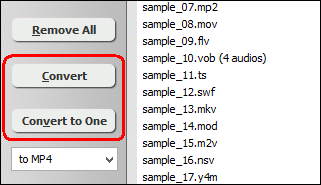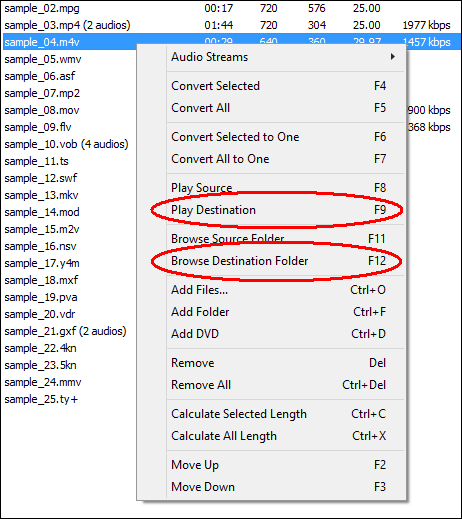 |
Convert MXF to MPEG
|
MXF to MPEG Converter converts MXF files to
MPEG. It's an easy-to-use and ALL-IN-ONE video and audio converter software.
The converter also converts media file to the major formats such as MKV, iPad, PS3, OGG, Wii and DS, iPod touch, Xvid, MP4,
etc. It could convert Y4M to WebM, RMVB to DivX, 3GPP to M4V, DXA to AVI, RMVB to Creative ZEN, DXA to VOB (DVD Video), and so on.
MXF to MPEG Converter supports batch conversion
that enables you convert bulk MXF files to MPEG at a time. The software is
full compatible with 32-bit and 64-bit editions Windows 10/8/7/Vista/XP/2000.

What is MXF?
The Material eXchange Format (MXF) is an open file format, targeted at the
interchange of audio-visual material with associated data and metadata. It has
been designed and implemented with the aim of improving file-based interoperability
between servers, workstations and other content-creation devices. These improvements
should result in improved workflows and in more efficient working practices than
is possible with today's mixed and proprietary file formats.
MXF has been designed by the leading players in the broadcast industry - with
an enormous amount of input from the user community - to ensure that the
format really meets their demands. It is being put forward as an Open Standard
which means it is a file transfer format that is openly available to all interested
parties. It is not compression-scheme-specific and it simplifies the integration
of systems using MPEG and DV as well as future, as yet unspecified, compression
strategies. This means that the transportation of these different files will be
independent of content, and will not dictate the use of specific manufacturers¡¯
equipment. Any required processing can simply be achieved by automatically invoking
the appropriate hardware or software codec. However, MXF is designed for operational
use and so all the handling processes are seamless to the user. It just works
quietly in the background.
Besides offering better interoperability - working with video and audio
between different equipment and different applications - its other major contribution
is the transport of metadata. By developing MXF from the beginning as a new file
format, considerable thought has gone into the implementation and use of metadata.
Not only is this important for the proper functioning of MXF files, it will also
enable powerful new tools for media management as well as improving the content-creation
workflows by eliminating repetitive metadata re-entry.
The changing technologies in television production, and in transmission to
the viewers, means that the traditional methods for moving the content -
programme video and audio - within studios is changing too. Not only is there
far greater use of computers and IT-related products such as servers, but also
the reliance on automation and the re-use of material have expanded. Besides the
need to carry metadata, file transfers are needed to fit in with computer operations
and they must be capable of being streamed for real-time operations.
The development of the Material eXchange Format (MXF) is a remarkable achievement
of collaboration between manufacturers and major organizations such as Pro-MPEG,
the EBU and the AAF Association. It establishes interoperability of content between
various applications used in the television production chain. This leads to operational
efficiency and creative freedom through a unified networked environment.
MXF is a "container" or "wrapper" format which supports
a number of different streams of coded "essence", encoded with any of
a variety of codecs, together with a metadata wrapper which describes the material
contained within the MXF file.
MXF was developed to carry a subset of the Advanced Authoring Format (AAF)
data model, under a policy known as the Zero Divergence Directive (ZDD). This
enables MXF/AAF workflows between non-linear editing (NLE) systems using AAF and
cameras, servers, and other devices using MXF.
What is MPEG?
The Moving Picture Experts Group (MPEG) was formed by the ISO to set standards
for audio and video compression and transmission. Its first meeting was in May
1988 in Ottawa, Canada. As of late 2005, MPEG has grown to include approximately
350 members per meeting from various industries, universities, and research institutions.
MPEG's official designation is ISO/IEC JTC1/SC29 WG11.
The MPEG standards consist of different Parts. Each part covers a certain aspect
of the whole specification. The standards also specify Profiles and Levels. Profiles
are intended to define a set of tools that are available, and Levels define the
range of appropriate values for the properties associated with them. MPEG has
standardized the following compression formats and ancillary standards:
- MPEG-1: The first compression standard for audio and video. It was
basically designed to allow moving pictures and sound to be encoded into the bitrate
of a Compact Disc. To meet the low bit requirement, MPEG-1 downsamples the images,
as well as uses picture rates of only 24-30 Hz, resulting in a moderate quality.
It includes the popular Layer 3 (MP3) audio compression format.
- MPEG-2: Transport, video and audio standards for broadcast-quality
television. MPEG-2 standard was considerably broader in scope and of wider appeal
- supporting interlacing and high definition. MPEG-2 is considered important because
it has been chosen as the compression scheme for over-the-air digital television
ATSC, DVB and ISDB, digital satellite TV services like Dish Network, digital cable
television signals, SVCD, and DVD.
- MPEG-3: Developments in standardizing scalable and multi-resolution
compression which would have become MPEG-3 were ready by the time MPEG-2 was to
be standardized; hence, these were incorporated into MPEG-2 and as a result there
is no MPEG-3 standard. MPEG-3 is not to be confused with MP3, which is MPEG-1
Audio Layer 3.
- MPEG-4: MPEG-4 uses further coding tools with additional complexity
to achieve higher compression factors than MPEG-2. In addition to more efficient
coding of video, MPEG-4 moves closer to computer graphics applications. In more
complex profiles, the MPEG-4 decoder effectively becomes a rendering processor
and the compressed bitstream describes three-dimensional shapes and surface texture.
MPEG-4 also provides Intellectual Property Management and Protection (IPMP) which
provides the facility to use proprietary technologies to manage and protect content
like digital rights management. Several new higher-efficiency video standards
(newer than MPEG-2 Video) are included (an alternative to MPEG-2 Video), notably:
- MPEG-4 Part 2 (or Simple and Advanced Simple Profile) and
- MPEG-4 AVC (or MPEG-4 Part 10 or H.264). MPEG-4 AVC may be used on
HD DVD and Blu-ray discs, along with VC-1 and MPEG-2.
In addition, the following standards, while not sequential advances to the
video encoding standard as with MPEG-1 through MPEG-4, are referred to by similar
notation:
- MPEG-7: A multimedia content description standard.
- MPEG-21: MPEG describes this standard as a multimedia framework.
Moreover, relatively more recently than other standards above, MPEG has started
following international standards; each of the standards holds multiple MPEG technologies
for a way of application. For example, MPEG-A includes a number of technologies
on multimedia application format.
- MPEG-A: Multimedia application format.
- MPEG-B: MPEG systems technologies.
- MPEG-C: MPEG video technologies.
- MPEG-D: MPEG audio technologies.
- MPEG-E: Multimedia Middleware.
How to Convert MXF to MPEG?
- Free Download
MXF to MPEG Converter
- Install the software by instructions
- Launch MXF to MPEG Converter
- Choose MXF Files

Click "Add Files" to choose MXF files and then add them
to conversion list.

Choose one or more MXF files you want to convert and then click Open.
- Choose "to MPG/MPEG"

You can also convert file to MP4 or MP2 with the program.
- Convert MXF to MPEG

Click on "Convert" to convert MXF files to MPEG format; alternatively,
click on "Convert to One" to convert all files in list and
combine to a single one MPEG file.

The software is converting MXF files to MPEG format.
- Play and Browse MPEG File

When conversion completes, you could right-click on converted file and choose
"Play Destination" to play the outputted MPEG file; or choose "Browse
Destination Folder" to open Windows Explorer to browse the MPEG file.
Top
MXF to MPEG Converter is 100% clean and safe to install.
It's certified by major download sites.

MXF to MPEG Related Topics:
|

